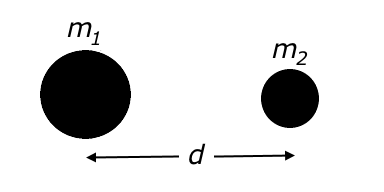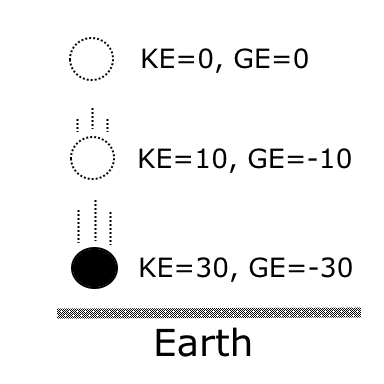Can the Universe be Uncreated?
Gravitational Energy:
Physicists tell us that gravitational energy is negative energy. How can this be? Why is gravitational energy negative? Understanding gravitational energy as negative energy is the key to understanding how the universe can exist or not exist, so let's get started.
Think of it this way:Two objects separated by an infinite distance feel no gravitational force of attraction. Sure, it took positive energy to separate these objects from each other, but the force between them is zero due to the infinite distance. It is convenient to call this infinite separation, the point of zero gravitational energy. Yes, this is the maximum gravitational energy possible between the two objects and we have called it zero. As the objects become close to each other, the gravitational energy is less than zero and therefore negative. It turns out that we could have called this energy at infinite separation a positive number such as +100 or +10 or 0 or even a negative number such as -10. It really makes no difference how we define the energy at infinite separation. Our conclusions will remain the same. The gravitational energy between objects can only get less as they come closer to each other. Any change from infinite separation results in less gravitational energy.
Let's see why this is so. If you hold a ball in the air and let it fall to the ground, the ball gains kinetic energy of motion as it falls. Since energy cannot be created or destroyed, where did this energy of motion come from? If we call the energy of motion positive, then we must have an equal decrease in energy. This positive gain in kinetic energy is offset by an equal decrease in gravitational energy as the ball falls to earth. Now you can understand why gravitational energy must be negative. As objects fall toward each other from a great distance, they gain in positive energy of motion which must be exactly offset by a decrease in gravitational energy since The Law of Conservation of Energy demands that the positive and negative energies must balance each other.
To make this clear, consider the two objects below separated by a distance d. These objects can be galaxies, stars, planets, moons or baseballs in any combination.

The gravitational energy between these two objects is:

Where:
G = Gravitational Constant
m1 = Mass of object1
m2 = Mass of object2
d = Distance between the objects
From this equation, we see that as the denominator, d, becomes infinite, the energy becomes zero. As the objects become closer, d becomes smaller, and the energy becomes non-zero and negative.
To further illustrate gravity as negative energy, consider the ball falling toward the earth in the figure below. Zero Kinetic Energy (KE) of motion and zero Gravitational Energy (GE) are used as a reference point at the start of the fall. Other reference points can be used with the same conclusion. As the ball falls, the kinetic energy increases while the gravitational energy becomes negative by an equal amount. The total energy of the system remains constant at zero during the fall since energy cannot be created or destroyed.
Mass Energy:
We are almost ready to uncreate the universe, but first, let's consider mass as energy. Einstein's famous equation shown below tells us that all matter in the universe is just very concentrated energy. You, me, and all the matter in the universe is energy. In Einstein's equation the mass is multiplied by a very large number (the speed of light squared) meaning that there is an enormous amount of energy in even a small amount of matter.

Where:
m = The mass of an object
c = The speed of light
The Interaction of Gravitational and Mass Energy:
The negative energy of gravity assembles galaxies, solar systems and the stars that convert light elements into heavy elements needed for life. It takes positive energy to undo this assembly of matter.
Without mass there is no gravitational energy. Mass and gravity go together. One does not exist without the other. Our universe is the result of this marriage of mass and gravity. Without mass and gravity, we have no universe. If we understand these energies, we should be able to understand our universe.
We know that energy can be converted from one type to another. Wind energy can be converted into electrical energy and electrical energy can be converted back into wind energy using a fan. The chemical energy in rocket fuel is converted into gravitational energy when the rocket lifts off the launching pad.
What if we use the mass energy of the rocket as fuel? As the rocket takes off, the mass energy decreases as the rocket gains in altitude. How far away could our rocket go before using up all its mass?
What if we expand this concept and take all of the mass in the universe and use this mass as fuel to separate all the objects from each other as shown in the picture below. What would happen? Would the universe actually be uncreated as mass energy is converted into gravitational energy?

Uncreating the Universe
As the objects in the universe are separating from each other, the energies are changing with time as shown below. ME is mass energy and GE is gravitational energy. The energy numbers are to illustrate the concept only.
| ME = 10000 | GE = -10000 | (start of separation) |
| ME = 1000 | GE = -1000 | (a later time) |
| ME = 100 | GE = -100 | (a later time) |
| ME = 10 | GE = -10 | (a later time) |
| ME = 1 | GE = -1 | (a later time) |
| ME = 0 | GE = 0 | (uncreation) |
This shows how the separating objects can eventually run out of mass fuel while the gravitational energy becomes zero. No mass means no gravity. Nothing is left. The universe has been uncreated.
So what does this tell us about a possible origin of the universe? If the universe can be uncreated by considering the interaction of mass and gravity, then could the creation of the universe be a result of a similar interaction between mass and gravity? The creation of the universe could be a reversal of the uncreation process as shown below. Again, ME is mass energy, GE is gravitational energy and the energy numbers are to illustrate the concept only.
| ME = 0 | GE = 0 | (an unstable nothing) |
| ME = 1 | GE = -1 | (a trigger event) |
| ME = 10 | GE = -10 | (Big Bang explosion underway) |
| ME = 100 | GE = -100 | (Big Bang expands) |
| ME = 1000 | GE = -1000 | (Big Bang continues) |
| ME = 10000 | GE = -10000 | (our universe) |
This shows how our universe can evolve from nothing. Note that the total energy of the universe sums to zero at each point in the uncreation and creation process obeying The Law of Conservation of Energy. The net energy is zero.
Understanding Gravity:
Math of Creation
